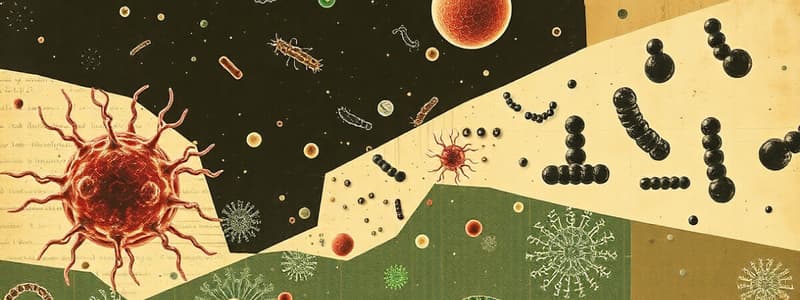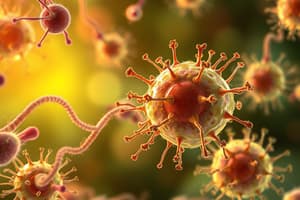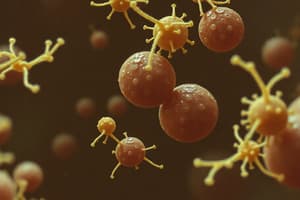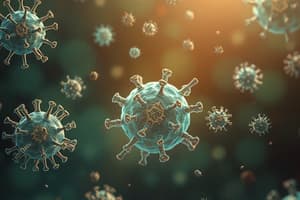Podcast
Questions and Answers
Which of the following best exemplifies the interconnectedness between humans and microbes, according to the content?
Which of the following best exemplifies the interconnectedness between humans and microbes, according to the content?
- The disproportionately large number of microbial cells compared to human cells in the human body. (correct)
- The classification of microbes into different groups based on shared characteristics.
- The use of microbes in the production of antibiotics.
- The role of microbes in causing infectious diseases in humans.
A researcher is studying a new infectious agent that replicates within cells but lacks cellular structure. Under which major group of human infectious disease agents does this agent likely fall?
A researcher is studying a new infectious agent that replicates within cells but lacks cellular structure. Under which major group of human infectious disease agents does this agent likely fall?
- Viruses (correct)
- Fungi
- Bacteria
- Protozoa
How does the classification of microorganisms contribute to our understanding of them?
How does the classification of microorganisms contribute to our understanding of them?
- It mainly serves to catalog the total number of different types of microbes in the world.
- It helps us identify organisms, arrange related organisms into groups, and provides insights into their evolution. (correct)
- It primarily focuses on identifying harmful microorganisms and developing methods to eliminate them.
- It is solely concerned with naming microorganisms and not with understanding their relationships.
How would a scientist primarily use taxonomy in the field of microbiology?
How would a scientist primarily use taxonomy in the field of microbiology?
A new species of bacteria is discovered. Which aspect of microbiology would be most directly involved in its naming and classification?
A new species of bacteria is discovered. Which aspect of microbiology would be most directly involved in its naming and classification?
Which activity demonstrates the application of microbiology in an industrial setting?
Which activity demonstrates the application of microbiology in an industrial setting?
A patient is diagnosed with a helminth infection. To which major group of human infectious disease agents do helminths belong?
A patient is diagnosed with a helminth infection. To which major group of human infectious disease agents do helminths belong?
Why is the study of microbiology considered important, based on the information provided?
Why is the study of microbiology considered important, based on the information provided?
Which of the following describes the primary role of the Golgi apparatus?
Which of the following describes the primary role of the Golgi apparatus?
How do lysosomes contribute to cellular homeostasis?
How do lysosomes contribute to cellular homeostasis?
Which of the following is a key distinction between bacteria and fungi?
Which of the following is a key distinction between bacteria and fungi?
How does the structure of the rough endoplasmic reticulum (rER) directly support its function?
How does the structure of the rough endoplasmic reticulum (rER) directly support its function?
Which of the following characteristics of mitochondria provides evidence for the endosymbiotic theory?
Which of the following characteristics of mitochondria provides evidence for the endosymbiotic theory?
A cell is exposed to a toxin that inhibits the function of ribosomes. Which of the following cellular processes would be most directly affected?
A cell is exposed to a toxin that inhibits the function of ribosomes. Which of the following cellular processes would be most directly affected?
Which of the following describes the collective function of vesicles originating from the Golgi apparatus?
Which of the following describes the collective function of vesicles originating from the Golgi apparatus?
If a eukaryotic cell were unable to produce functional peroxisomes, what would be the most likely consequence?
If a eukaryotic cell were unable to produce functional peroxisomes, what would be the most likely consequence?
What are the two major contributions of the Linnaean scheme to modern biological classification?
What are the two major contributions of the Linnaean scheme to modern biological classification?
According to the Linnaean system, which of the following taxonomic ranks is the broadest?
According to the Linnaean system, which of the following taxonomic ranks is the broadest?
Which of the following criteria is NOT typically used in classifying organisms into species and broader categories?
Which of the following criteria is NOT typically used in classifying organisms into species and broader categories?
How does the classification of microorganisms into species differ from the classification of plants and animals?
How does the classification of microorganisms into species differ from the classification of plants and animals?
What is the main characteristic that distinguishes prokaryotes from eukaryotes?
What is the main characteristic that distinguishes prokaryotes from eukaryotes?
Why are viruses neither classified as prokaryotes nor eukaryotes?
Why are viruses neither classified as prokaryotes nor eukaryotes?
What is the function of peptidoglycan in prokaryotic cells, and where is it found?
What is the function of peptidoglycan in prokaryotic cells, and where is it found?
What is the primary function of bacterial fimbriae?
What is the primary function of bacterial fimbriae?
What is the main difference between bacterial endospores and cysts?
What is the main difference between bacterial endospores and cysts?
What is the purpose of Gram staining in classifying prokaryotes?
What is the purpose of Gram staining in classifying prokaryotes?
Which of the following structures is NOT typically found in eukaryotic cells?
Which of the following structures is NOT typically found in eukaryotic cells?
How does the organization of DNA differ between prokaryotes and eukaryotes?
How does the organization of DNA differ between prokaryotes and eukaryotes?
A bacterium is isolated and found to be able to survive in extremely dry conditions. Which structure is most likely contributing to this ability?
A bacterium is isolated and found to be able to survive in extremely dry conditions. Which structure is most likely contributing to this ability?
Which of the following describes the role of the glycocalyx in eukaryotic cells?
Which of the following describes the role of the glycocalyx in eukaryotic cells?
If a new microorganism is discovered and its cells are observed to divide by mitosis, into which major group of organisms would it be classified?
If a new microorganism is discovered and its cells are observed to divide by mitosis, into which major group of organisms would it be classified?
A previously motile protozoan species loses its ability to produce functional flagella. How would this affect its classification?
A previously motile protozoan species loses its ability to produce functional flagella. How would this affect its classification?
In a marine environment, what would be the most significant consequence if a large portion of the single-celled algae population, such as diatoms and dinoflagellates, were to suddenly die off?
In a marine environment, what would be the most significant consequence if a large portion of the single-celled algae population, such as diatoms and dinoflagellates, were to suddenly die off?
A researcher is developing a new antiviral drug. Which aspect of viral biology presents the greatest challenge in creating a drug that selectively targets the virus without harming the host cell?
A researcher is developing a new antiviral drug. Which aspect of viral biology presents the greatest challenge in creating a drug that selectively targets the virus without harming the host cell?
A protozoan is found to cause disease by directly destroying host cells during its replicative cycle. Which human disease is most likely caused by this type of protozoan?
A protozoan is found to cause disease by directly destroying host cells during its replicative cycle. Which human disease is most likely caused by this type of protozoan?
How does the structural simplicity of viruses, specifically their lack of metabolic machinery, impact their interaction with living organisms?
How does the structural simplicity of viruses, specifically their lack of metabolic machinery, impact their interaction with living organisms?
Flashcards
Microbiology
Microbiology
The science that studies microorganisms and their effects on life.
Pathogens
Pathogens
Microorganisms that cause disease in humans.
Taxonomy
Taxonomy
The science of classifying organisms into groups.
Carolus Linnaeus
Carolus Linnaeus
Signup and view all the flashcards
Types of Microorganisms
Types of Microorganisms
Signup and view all the flashcards
Virology
Virology
Signup and view all the flashcards
Bacteriology
Bacteriology
Signup and view all the flashcards
Immunology
Immunology
Signup and view all the flashcards
Mitochondria
Mitochondria
Signup and view all the flashcards
Plasma Membrane
Plasma Membrane
Signup and view all the flashcards
Nucleus
Nucleus
Signup and view all the flashcards
Rough Endoplasmic Reticulum (rER)
Rough Endoplasmic Reticulum (rER)
Signup and view all the flashcards
Ribosomes
Ribosomes
Signup and view all the flashcards
Golgi Apparatus
Golgi Apparatus
Signup and view all the flashcards
Lysosomes
Lysosomes
Signup and view all the flashcards
Bacteria
Bacteria
Signup and view all the flashcards
Linnaean scheme
Linnaean scheme
Signup and view all the flashcards
Species definition
Species definition
Signup and view all the flashcards
Genus
Genus
Signup and view all the flashcards
Taxonomic hierarchy
Taxonomic hierarchy
Signup and view all the flashcards
Prokaryotes
Prokaryotes
Signup and view all the flashcards
Eukaryotes
Eukaryotes
Signup and view all the flashcards
Binary fission
Binary fission
Signup and view all the flashcards
Cell wall in Prokaryotes
Cell wall in Prokaryotes
Signup and view all the flashcards
Endospores
Endospores
Signup and view all the flashcards
Grams Stain
Grams Stain
Signup and view all the flashcards
Capsules
Capsules
Signup and view all the flashcards
Pili
Pili
Signup and view all the flashcards
Flagella
Flagella
Signup and view all the flashcards
Protozoa
Protozoa
Signup and view all the flashcards
Movement in Protozoa
Movement in Protozoa
Signup and view all the flashcards
Algae
Algae
Signup and view all the flashcards
Viruses
Viruses
Signup and view all the flashcards
Photosynthesis in Algae
Photosynthesis in Algae
Signup and view all the flashcards
Study Notes
Microbiology Overview
- Microbiology is the study of microorganisms and their impact on life.
- Microorganisms are widely distributed in nature, some beneficial, some harmful (pathogens).
- Key groups include viruses, bacteria, fungi, parasites, algae, and protozoa.
- Virology (viruses), Bacteriology (bacteria), Mycology (fungi), Parasitology (parasites), Immunology (immunity), Phycology (algae), and Protozoology (protozoa) are specific branches within microbiology.
- Pathogenic microbes are agents of infectious disease.
- Viruses are non-cellular and replicate only within host cells.
Microbial Importance
- Microorganisms are crucial for various processes, including food production (bread, cheese, beer), antibiotic and vaccine production, vitamin and enzyme synthesis.
- Microbes are ubiquitous, with over 5 x 1030 types worldwide.
- Humans have a complex relationship with microbes, with over 100 trillion microbes residing on and within the average human body (majority non-human).
Classification of Organisms
- Classification (taxonomy) provides criteria for identifying organisms, arranges them into groups based on shared characteristics, and reveals evolutionary relationships.
- Carolus Linnaeus developed a hierarchical system of classification, using species, genus, family, order, class, phylum/division, and kingdom.
- Species definition varies: In animals and plants- breeding populations; in microorganisms- 70% biochemical similarity
- Taxonomists use various criteria (morphology, cellular features, biochemical properties, genetic characteristics, elicited antibodies, nutritional requirements, staining characteristics) for classification.
Prokaryotes and Eukaryotes
- Microorganisms are grouped into prokaryotes and eukaryotes.
- Prokaryotes (bacteria): Simple cells without a nucleus or membrane-bound organelles, circular DNA, cell walls with peptidoglycan. Reproduction by binary fission, diverse shapes (cocci, bacilli, spirilla/spirochetes).
- Eukaryotes (fungi, protozoa, algae): Complex cells with a nucleus and membrane-bound organelles, linear DNA. Cell walls (if present) are chemically diverse. Reproduction typically involves mitosis.
- Viruses: neither prokaryotes nor eukaryotes; non-cellular, relying on host cells for replication.
Prokaryotic Cell Structure
- Cell Wall: Peptidoglycan, diverse layers (Gram-positive vs Gram-negative, differing in peptidoglycan amount/layers).
- Capsules: Gelatinous layers (glycocalyx, slime layer) surrounding some cells for protection.
- Plasma Membrane: Phospholipid bilayer enclosing the cell contents; transporting and signaling systems.
- Flagella: Whip-like appendages for motility.
- Pili/Fimbriae: Hair-like structures for attachment.
- Endospores/Cysts: Dormant structures enabling survival in adverse conditions (endospores are more resistant to heat than cysts).
Eukaryotic Cell Structure
- Membrane-bound nucleus: Contains DNA, nucleolus (RNA synthesis).
- Plasma membrane: Phospholipid bilayer, control access to cell and participate in cell signaling.
- Cytoplasm: Contents within the cell, including cytoskeleton (filaments, microtubules).
- Mitochondria: Double membrane, ATP production via metabolism ("powerhouse”).
- Endoplasmic Reticulum (ER): Membrane network, Rough ER involved in protein synthesis; Smooth ER in lipid synthesis.
- Golgi apparatus: Stacked membranes, protein processing and packaging.
- Ribosomes: Cellular protein synthesis machinery.
- Centrioles (animal cells): Cell division.
- Lysosomes: Digestion of cellular waste and engulfed materials.
- Peroxisomes: Decomposition of harmful molecules (hydrogen peroxide).
Brief Descriptions of Microorganisms
- Bacteria: Simple, prokaryotic, diverse shapes (rods, spheres, spirals), reproduce by binary fission.
- Fungi: Eukaryotic, unicellular (yeasts), multicellular (molds), prefer acidic environments, reproduction via spores.
- Molds: Filamentous fungi, spore production.
- Yeasts: Unicellular fungi, used in fermentation.
- Protozoa: Eukaryotic, single-celled, many motile, some non-motile, diverse shapes due to lack of cell walls, cause diseases like malaria, sleeping sickness, dysentery, and toxoplasmosis. Movement via flagella, cilia, or pseudopodia.
- Algae: Plant-like organisms, some single-celled, important parts of marine food chains (diatoms, dinoflagellates), perform photosynthesis.
- Viruses: Ultramicroscopic, genetic material (DNA or RNA) enclosed in a protein shell (sometimes a membrane), non-metabolic, replicate in living cells using host cell machinery. Often cause cell destruction during replication.
Studying That Suits You
Use AI to generate personalized quizzes and flashcards to suit your learning preferences.




